How to properly eat a traditional Japanese tonkatsu meal
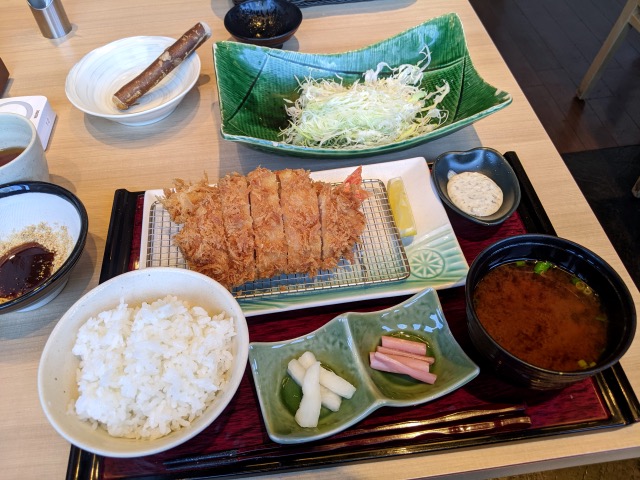
A lesson in etiquette to help guide you through the way of the tonkatsu.
There are a number of popular restaurant chains that serve up a good tonkatsu (fried pork cutlet) in Japan. However, for our reporter Mr Sato, the best of them all is Shinjuku Saboten, a nationwide chain that has over 50 years of experience serving excellent set meals to both eat-in and takeout diners.
Not only are their meals delicious, and made with high-quality ingredients, they serve them impeccably, with everything you need to enjoy a premium dining experience. However, with so many dishes included, it can be hard for first-time diners to know how to properly go about eating their meal, but that’s okay because the chain has a special “tonkatsu etiquette manual” on their website.
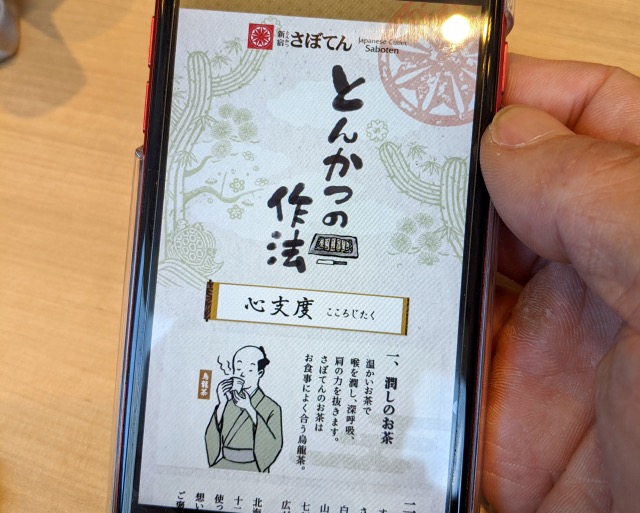
According to Saboten, there are eight steps to getting the most out of a tonkatsu meal, but before that, we have to order one. Mr Sato ordered the Aged Sangen Mugi Pork Loin Cutlet (95 grams [3.35 ounces]) and Fried Shrimp Platter Set for 1,330 yen (US$9.59), which can be seen at the bottom left of the menu below.
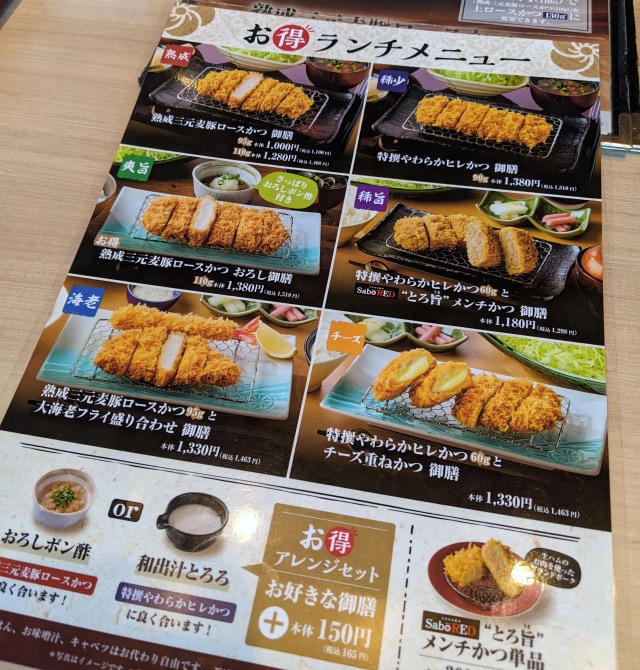
Though the meals look elegant, Saboten doesn’t have any unnecessary airs about it — it even has an official character called Sakusaku Katsumon, with “saku saku” referring to the “crunchy” texture of the cutlets served here, and “mon” being a cute suffix sometimes adopted by characters such as Kumamon.
▼ Sakusaku Katsumon, pictured in the middle dancing with friends Puripuri Ebimon (Plump Shrimp) and Okawari Kyabemon (Cabbage Refill).
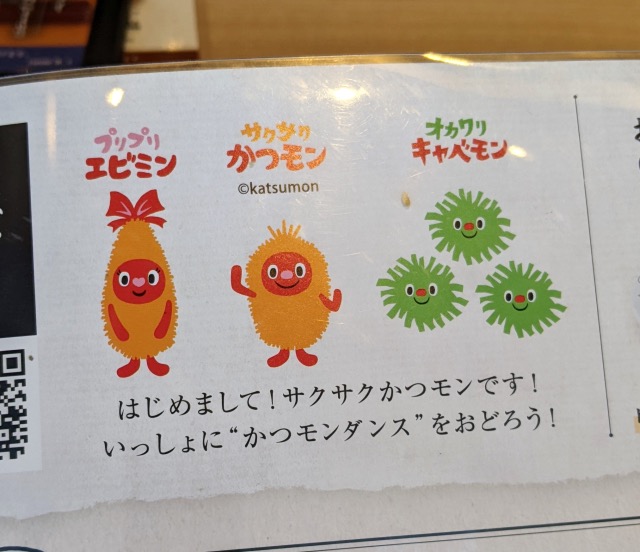
The meals here are suitable for adults and children, but those wanting to get serious about their tonkatsu will want to consult the etiquette manual, which is split into two four-step parts — “Mental Preparation” and “Rising of the Curtain”.
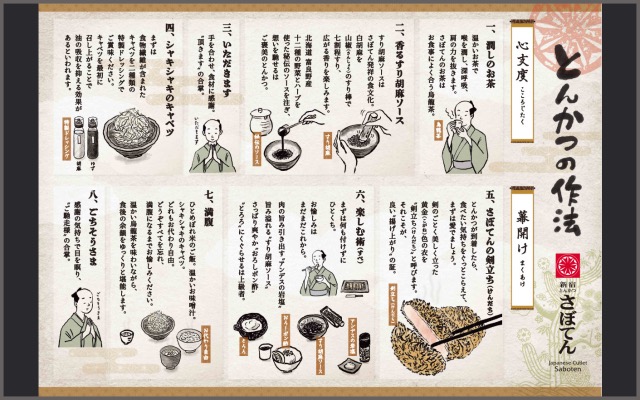
The first step is to moisten the palate with tea, and Saboten serves oolong tea as they believe it pairs well with tonkatsu.

The next step is to prepare the “Aromatic Ground Sesame Sauce” by grinding the sesame seeds, using the grooved mortar and wooden pestle provided.
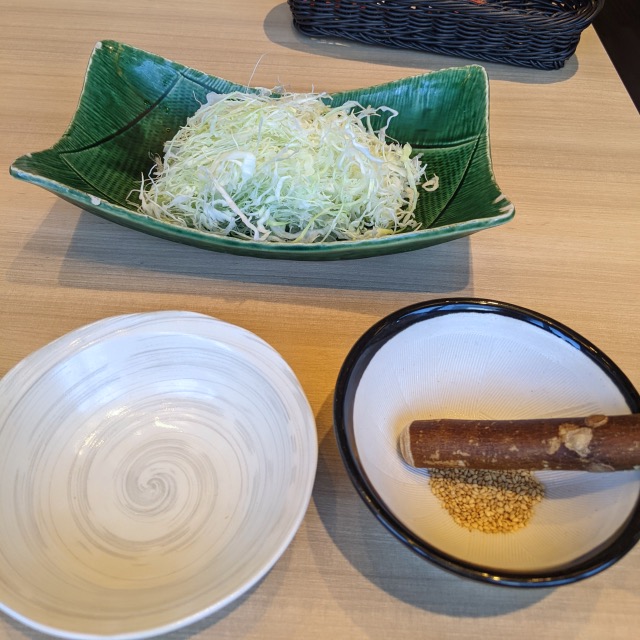
▼ The way of the tonkatsu requires patience and concentration.
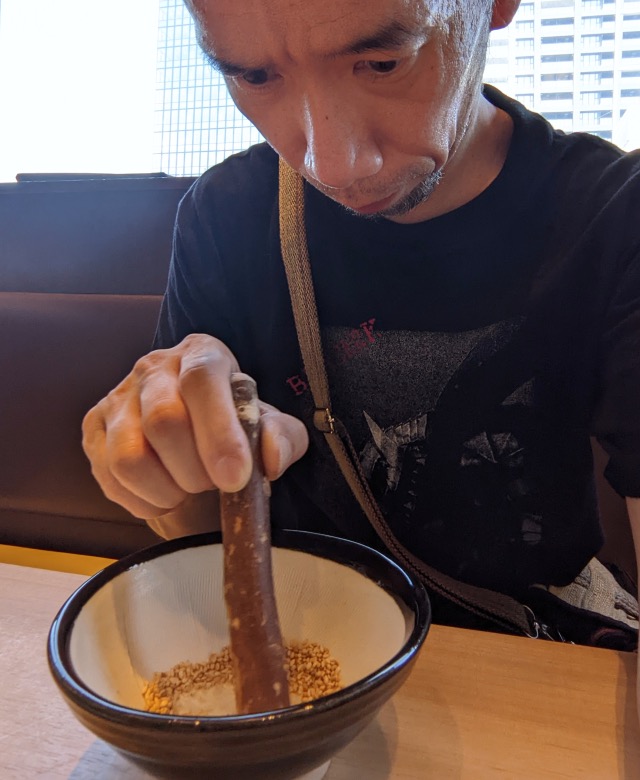
Once around 70 percent of the sesame seeds are ground, to give it a smooth yet slightly crunchy mouthfeel, pour some tonkatsu sauce into the bowl.
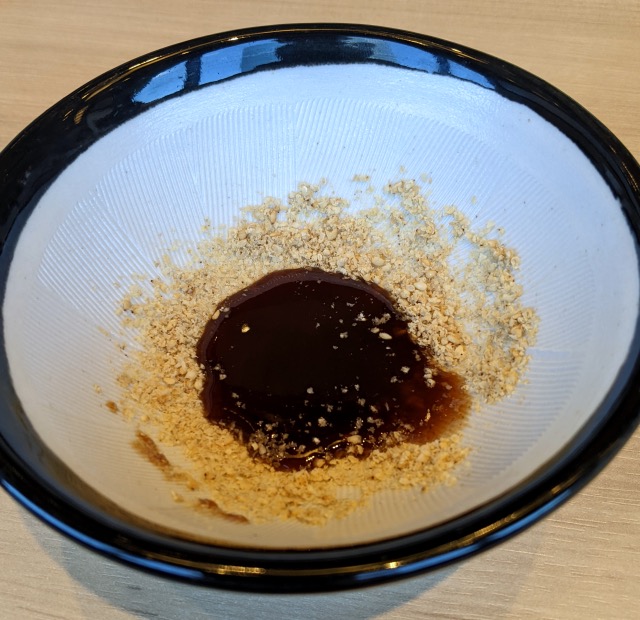
Now it’s time to press your hands together and say “itadakimasu“, as is customary in Japan when expressing thanks for the meal you are about to eat.
▼ Mr Sato couldn’t press his palms together and take a selfie at the same time so he felt the “itadakimasu” within his heart.

The final step in the preparation process is to add the dressings to the cabbage and then enjoy a mouthful. The crunchy cabbage lines your stomach and prepares your palate for the meal that’s to come.
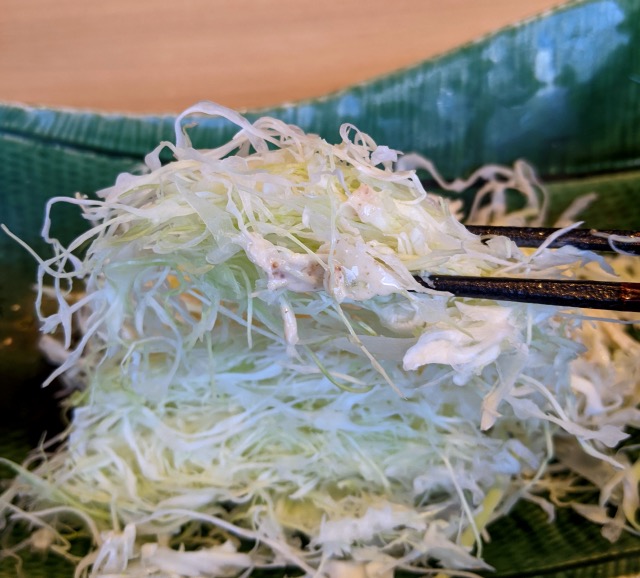
Now it’s time for the curtain to rise on the main event, which begins with something called Saboten no Kendachi (literally “Saboten’s standing sword“).

This is a very important point, so Mr Sato would like to quote it in its entirety.
“When the tonkatsu arrives, hold back your urge to eat it, and let’s admire it first. The golden coloured coating that juts out like swords is called kendachi. That is the proof of good frying”.

▼ Mr Sato followed these sage instructions, admiring the cutlet’s golden coating of fried breadcrumbs.
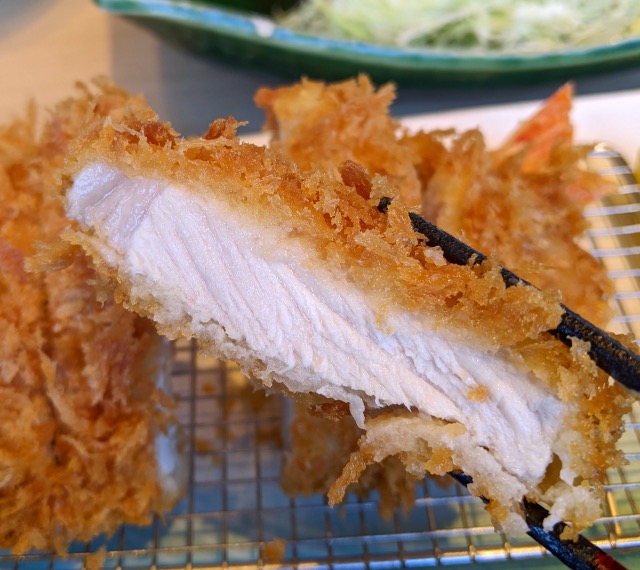
▼ The golden crumbs stood out like little swords, with beautiful tips that could pierce the heavens.
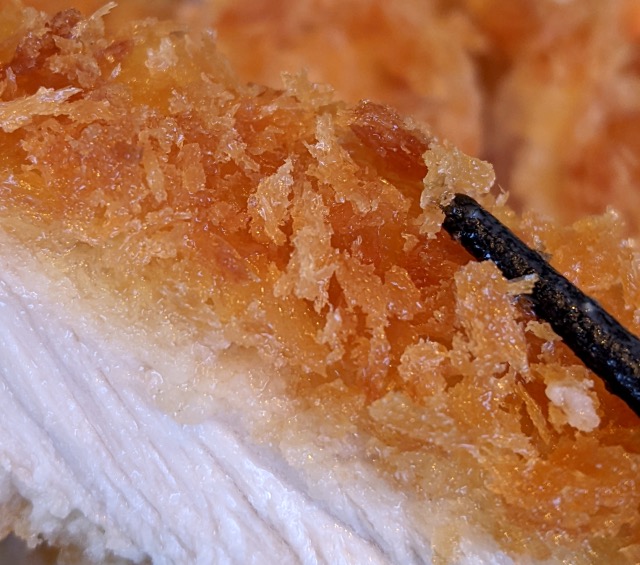
The moments spent admiring the beautifully fried exterior made Mr Sato feel as if he were about to eat a product forged by a famous craftsman.

▼ The sixth step was to eat a bite of tonkatsu on its own, without adding anything to it.

It was a delicious bite that highlighted the true glory of the fried exterior, but Mr Sato still prefers his tonkatsu with a good dollop of tonkatsu sauce. Thankfully, the sixth step recommends eating the tonkatsu with sauce after the first bite, and enjoying it between mouthfuls of cabbage, rice, soup and pickles while being mindful of all the different textures and flavours.
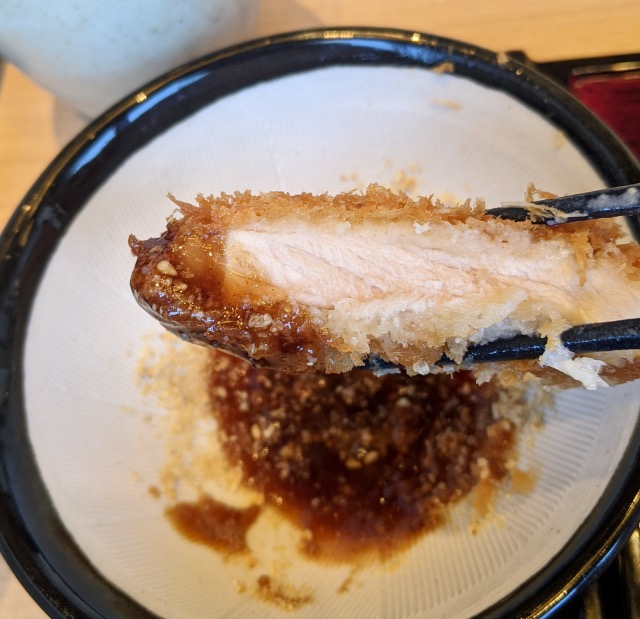
Ohhhhh yessss. Now this was more like it — the aroma of the sesame and the slight tartness of the sauce brought out the sweetness of the pork beautifully.

Because he’d been observing the etiquette guide and suppressing the urge to eat so far, the first bite of saucy tonkatsu made Mr Sato’s appetite explode into overdrive. He quickly heaped mouthfuls of delicious food into his mouth, only slowing down when he came to the fried shrimp, where he stopped to admire the kendachi once again.
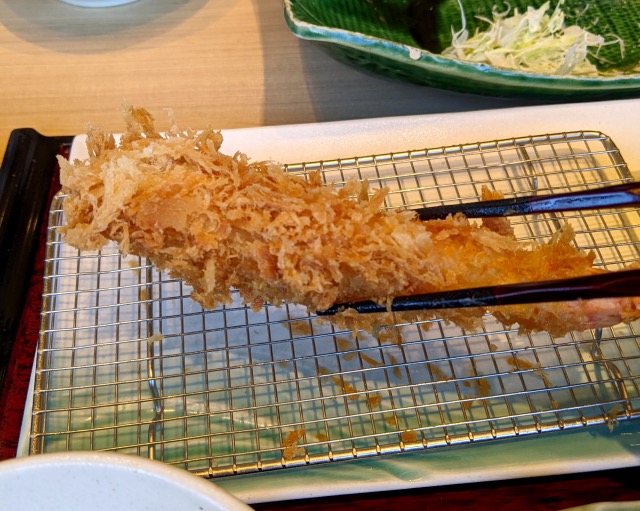
Mr Sato could feel an extraordinary “chi” energy drifting from the blades of fried breadcrumbs, and after adorning it with a dollop of tartar sauce on the tip…

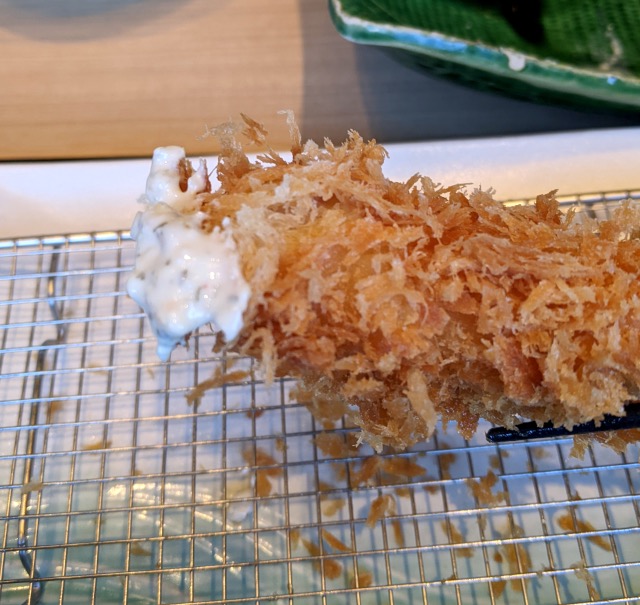
▼ …it slayed him with its deliciousness!!

Mr Sato has eaten a lot of fried shrimp in his time, but this was a masterpiece — the coating was superb and the oil had been well drained, giving it an intense crunch that remained crisp even after it had cooled down.
Now all that was left to do was complete the final two steps, with step 7 being to request free refills of cabbage, rice or miso soup until you feel satiated, and step 8 being to put your palms together and say “gochisosama”, as is customary when finishing meals in Japan, to express thanks for the food you’ve just eaten.
▼ With his hands once again busy taking selfies, Mr Sato closed his eyes and whispered “gochisosama” in thanks for the feast.

It’s been over half a century since Saboten was founded in 1966, and their expertise in the way of the tonkatsu is truly outstanding. Whether you’re new to this Japanese dish, or an old hand like Mr Sato, a visit to Saboten will totally convert you to the wonders of this restaurant chain, and if you can be patient enough to follow the eight-step etiquette guide, it’ll make the meal taste even better.
Mindful eating really does have the power to elevate a dining experience, so Mr Sato highly recommends trying it — even when you’re eating tonkatsu from the ‘King of Tonkatsu’ on a bench in Tokyo.
Related: Shinjuku Saboten
Images ©SoraNews24
● Want to hear about SoraNews24’s latest articles as soon as they’re published? Follow us on Facebook and Twitter!
Credit:

0 comments:
Post a Comment